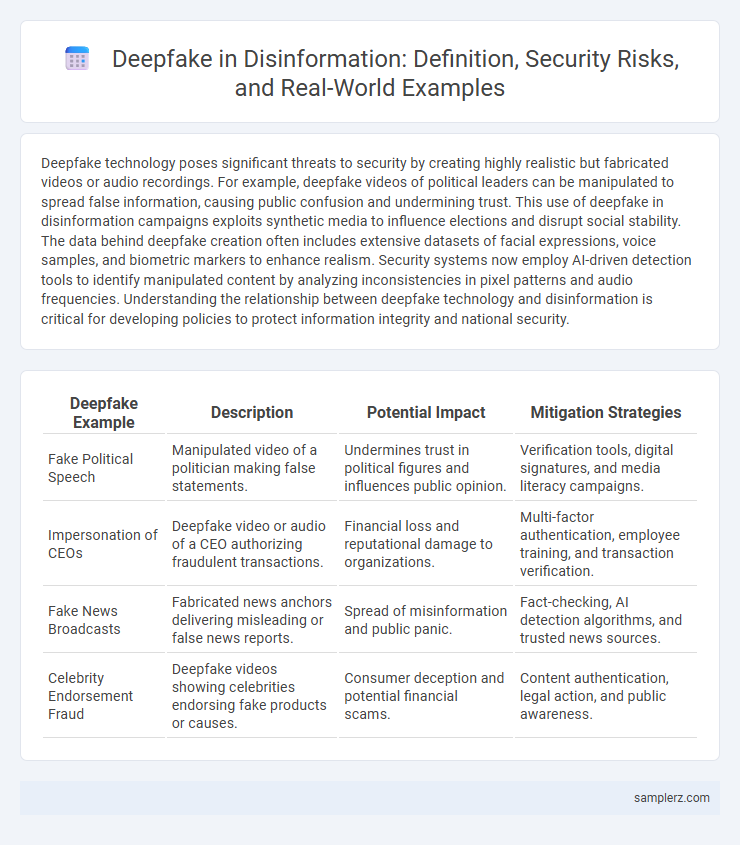Deepfake technology poses significant threats to security by creating highly realistic but fabricated videos or audio recordings. For example, deepfake videos of political leaders can be manipulated to spread false information, causing public confusion and undermining trust. This use of deepfake in disinformation campaigns exploits synthetic media to influence elections and disrupt social stability. The data behind deepfake creation often includes extensive datasets of facial expressions, voice samples, and biometric markers to enhance realism. Security systems now employ AI-driven detection tools to identify manipulated content by analyzing inconsistencies in pixel patterns and audio frequencies. Understanding the relationship between deepfake technology and disinformation is critical for developing policies to protect information integrity and national security.
Table of Comparison
| Deepfake Example | Description | Potential Impact | Mitigation Strategies |
|---|---|---|---|
| Fake Political Speech | Manipulated video of a politician making false statements. | Undermines trust in political figures and influences public opinion. | Verification tools, digital signatures, and media literacy campaigns. |
| Impersonation of CEOs | Deepfake video or audio of a CEO authorizing fraudulent transactions. | Financial loss and reputational damage to organizations. | Multi-factor authentication, employee training, and transaction verification. |
| Fake News Broadcasts | Fabricated news anchors delivering misleading or false news reports. | Spread of misinformation and public panic. | Fact-checking, AI detection algorithms, and trusted news sources. |
| Celebrity Endorsement Fraud | Deepfake videos showing celebrities endorsing fake products or causes. | Consumer deception and potential financial scams. | Content authentication, legal action, and public awareness. |
Notorious Deepfake Disinformation Campaigns
Notorious deepfake disinformation campaigns have exploited AI-generated videos to impersonate political leaders, spreading false narratives and undermining public trust. High-profile cases include manipulated footage of government officials delivering fake statements that fueled misinformation during election cycles. These sophisticated deepfakes pose significant threats to national security by eroding credibility and inciting social unrest.
Political Manipulation Using Deepfake Videos
Deepfake technology enables the creation of hyper-realistic fake videos that can falsely depict politicians making controversial statements or engaging in illicit activities, significantly impacting public opinion. These manipulated videos are strategically disseminated on social media platforms to sow distrust, polarize communities, and influence election outcomes. The 2020 US presidential election saw multiple attempts of political manipulation using deepfake videos, highlighting the urgent need for advanced detection tools and regulatory frameworks to combat disinformation.
Deepfakes in Election Interference
Deepfakes have increasingly been used as tools for election interference by creating highly realistic yet fabricated videos of political candidates to manipulate public perception and discredit opponents. These synthetic media exploit artificial intelligence algorithms to alter facial expressions and speech patterns, making it difficult to detect authenticity. The proliferation of deepfake technology poses significant risks to electoral integrity, undermining voter trust and amplifying misinformation campaigns.
Celebrity Deepfakes and False Endorsements
Celebrity deepfakes manipulate public perception by creating hyper-realistic videos where famous figures appear to endorse products or political messages they never supported. These false endorsements exploit the trust and influence celebrities hold, spreading disinformation rapidly across social media platforms and damaging reputations. The rising sophistication of AI-generated deepfakes poses significant challenges for verifying authenticity and combating misleading content in online security frameworks.
Deepfake Audio in Social Engineering Attacks
Deepfake audio enables cybercriminals to impersonate trusted individuals, manipulating victims into divulging sensitive information or transferring funds in social engineering attacks. Voice synthesis technology replicates unique speech patterns, making fraudulent calls almost indistinguishable from genuine ones. This sophisticated tactic poses significant risks to corporate security and personal privacy, challenging traditional authentication methods.
Synthetic Media Used in Fake News
Synthetic media, particularly deepfake videos, have become a powerful tool in spreading disinformation by creating hyper-realistic but entirely fabricated content. These manipulated videos are often used to falsely depict public figures in compromising situations, undermining trust in legitimate news sources and influencing public opinion. The use of AI-generated synthetic media in fake news campaigns poses significant challenges for cybersecurity and misinformation detection systems.
Deepfake Scams Targeting Corporations
Deepfake scams targeting corporations exploit advanced AI to create convincing fake videos or audio of executives, often used to manipulate financial transactions or leak sensitive information. These sophisticated attacks bypass traditional security measures, causing substantial financial and reputational damage. Organizations must implement robust verification protocols and employee training to detect and prevent such deepfake-based disinformation threats.
Viral Social Media Hoaxes with Deepfakes
Viral social media hoaxes often leverage deepfake technology to create convincing fake videos of public figures spreading false information, significantly amplifying disinformation campaigns. These manipulated videos exploit advanced AI-driven facial synthesis, increasing the difficulty of detecting fabricated content and deceiving millions of users worldwide. Platforms like Facebook, Twitter, and TikTok face growing challenges in moderating such deepfake hoaxes that threaten public trust and influence geopolitical events.
Deepfakes in International Propaganda Efforts
Deepfakes have become critical tools in international propaganda efforts, where manipulated videos of world leaders are used to spread false narratives and incite political instability. For instance, deepfake videos portraying fabricated speeches by political figures like Vladimir Putin or Joe Biden have been disseminated to influence public opinion and disrupt diplomatic relations. These synthetic media creations exacerbate disinformation campaigns by eroding trust in legitimate news sources and complicating verification processes in global security environments.
Preventing the Spread of Deepfake Disinformation
Deploying advanced AI detection tools that analyze digital artifacts and metadata signatures significantly aids in identifying deepfake content before it spreads. Implementing multi-factor authentication and secure verification protocols on social media platforms limits unauthorized dissemination of manipulated media. Public awareness campaigns focused on educating users about deepfake risks and promoting critical evaluation of suspicious videos reduce the impact of disinformation campaigns.

example of deepfake in disinformation Infographic
 samplerz.com
samplerz.com